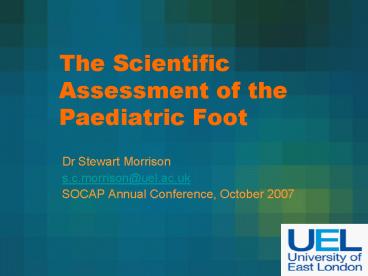The Scientific Assessment of the Paediatric Foot
1 / 22
Title:
The Scientific Assessment of the Paediatric Foot
Description:
Forefoot Alignment 'method of visually rating forefoot frontal plane deformities is unreliable and ... Reliability of Visual Measurement of Forefoot Alignment. ... –
Number of Views:84
Avg rating:3.0/5.0
Title: The Scientific Assessment of the Paediatric Foot
1
The Scientific Assessment of the Paediatric Foot
- Dr Stewart Morrison
- s.c.morrison_at_uel.ac.uk
- SOCAP Annual Conference, October 2007
2
Aims
- To comprehend the scientific principles of
measurement - To be able to apply scientific principles to the
assessment of the paediatric patient - To acknowledge the influence of scientific
principles on developing, supporting and
enhancing patient care
3
The Science
1. Systematic experimentation and analysis
1 2 Evidence based Practice
2. Application to current practice recognition
of changing practice
4
The goal of the Physician is to accurately and
effectively diagnose and treat an individual
patient. This is a time sensitive process in
which the art of medical practice can be
augmented by learning how to best attain the
maximum research information in an expeditious
manner. Waldman, (2007).
5
Principles of Measurement
Describing Quantifying Comparing Interpreting
Diagnosing .
- Clinicians use measurement as a means of
evaluating a patients condition and response to
treatment that is, we measure change or
progress2
6
Understand
13 year old female Turners Syndrome Medial ankle
pain
Differentiate
Evaluate
7
Clinical Relevance
- Accurate diagnosis
- Continuity of care
- Quality of care
- Efficacy of clinical practice
8
- Briefly review the concepts of validity,
reliability, sensitivity and specificity. - Apply these principles to your practice, what
outcomes do you measure, are these suitable?
9
Reliability
- the extent to which a measurement is consistent
and free from error2 - reliability is fundamental to all aspects of
measurement2
10
Validity
- the extent to which an instrument measures what
it is intended to measure2
- ability to accurately assess the presence and
absence of the target condition2
11
Specificity / Sensitivity
- the tests ability to obtain a negative test
when a condition is really absent2
- a tests ability to obtain a positive test when
the target condition is really present2
12
Sensitivity
Specificity
Reliability
Validity
Navicular Drop
13
Barriers to Scientific Assessment
- Interpretation
- Experience
- Complexity
- Anatomical variation
- The Child
- The Normal
- Time
14
Musculoskeletal Foot Examination
- Joint range of motion
- Muscle power
- Biomechanical alignment
- Static dynamic foot function (foot posture
index, footprint indices)
15
Range of Motion
- measures of ankle dorsiflexion in children are
highly variable 3 - gastrocnemius range of motion is more reliable
than soleal range of motion 3
16
Muscle Power/Spasticity Measures
Level of force?
Duration of force?
- Modified Ashworth Scale
- Modified Tardieu Scale
MRC Muscle Power Scale
Cerebral palsy, Duchennes, JIA
17
Forefoot Alignment
- method of visually rating forefoot frontal plane
deformities is unreliable and of questionable
clinical value4
18
Standing Foot Posture
Foot Posture Index
Anthropometrics
Footprint parameters
19
Other areas for consideration
- Gait Analysis
- Pain (VAS)
- Foot Function (FFI)
- Quality of Life (FHSQ)
20
Outcomes
- Are the outcomes we use supporting best patient
care? - Do the outcomes we use support the development of
practice? - Is the evidence base supporting current practice?
21
Development of Practice Childhood Obesity
22
References
- 1. Waldman, M.H. (2007) The practice of
evidence-based medicine What it is and why it
is important. The Foot. 17, pp. 117-118. - 2. Portney, L.G. Watkins, M.P. Foundations of
Clinical Research. New Jersey Prentice-Hall - 3. Evans, A.M. Scutter, S.D. (2006) Saggital
Plane Range of Motion of the Pediatric Ankle
Joint. Journal of the American Podiatric Medical
Association. 96 (5), pp. 418 422. - 4. Cornwall, M.W, McPoil, T.G., Fishco, W.D.,
Hunt, L., Lane, C., ODonnell, D. (2004)
Reliability of Visual Measurement of Forefoot
Alignment. Foot Ankle International. 25 (10),
pp. 745 748































